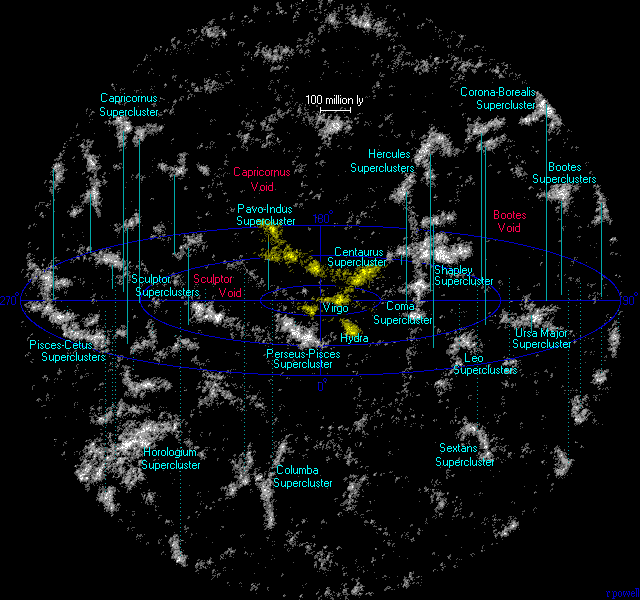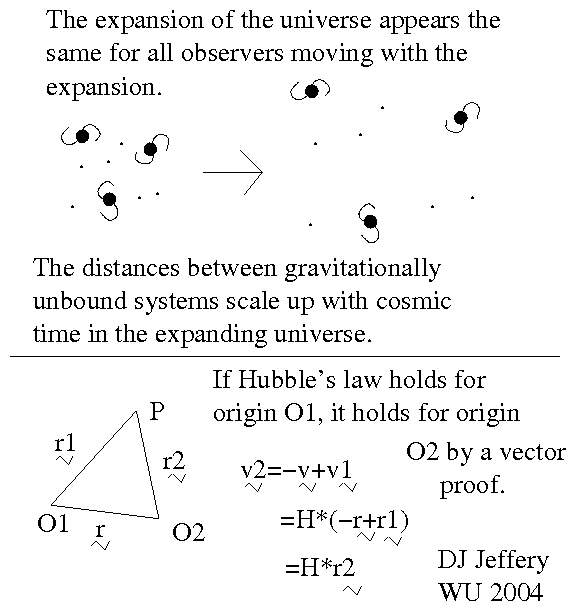Note, however, there is NO absolute hard line between galaxy clusters and galaxy superclusters
In fact, identifying a structure of large-scale structure as a galaxy supercluster has generally been somewhat in the eye of the beholder: e.g., "It looks like galaxy supercluster to me."
In fact, galaxy superclusters are amorphous.
There is a precise procedure for defining galaxy superclusters, but it requires rather precise information about galaxy motions which may NOT be available any time soon for galaxies more than ∼ 100 Mpc from the Local Group (i.e., the galaxy group to which the Milky Way belongs). The precise procedure has been used to define the Laniakea Supercluster (which includes Local Group): see below Image 2 for the Laniakea Supercluster.
A comoving frame can be defined at any point in space.
You just center on the point a large sphere which grows with the mean expansion of the universe: i.e., its radius scales up with the cosmic scale factor a(t), where t is cosmic time measured from the Big Bang singularity which was lookback time equal to the age of the universe = 13.799(21) Gyr.
The sphere is the comoving frame. Note the coordinate system for the comoving frame is NOT rotating relative to the observable universe just as for any other CM inertial frame.
And the center point of the sphere is the center of mass of the comoving frame.
The centers of mass of comoving frame participate in the mean expansion of the universe. Thus, the distances between the centers of mass scale with the cosmic scale factor a(t).
Currently, for the local (and therefore modern) observable universe the scale is estimated to be ∼ 370 Mpc (Wikipedia: Cosmological principle: Violations of homogeneity). However, there may be structures that are ∼ 1 Gpc in size scale (Wikipedia: Cosmological principle: Violations of homogeneity), but these may be just extreme fluctuations that may NOT be too important average structure formation (AKA large-scale structure formation).
Taking the scale 370 Mpc a valid, one can infer (from a calculation NOT give here), the radius of a comoving frame should be ∼ 320 Mpc for local observable universe.
However, this radius implies a recession velocity (cosmological growth of outer space rate) for the spherical surface of the comoving frame of ∼ 7.5 % of the vacuum light speed c = 2.99792458*10**8 m/s (exact by definition) ≅ 3*10**8 m/s = 3*10**5 km/s ≅ 1 ft/ns. Such a high recession velocity means the comoving frame is verging on requiring relativistic physics (combined special relativity (1905) general relativity (1915)) for high accuracy analysis of the INTERNAL motions. However, using relativistic physics means, you are NOT imposing inertial frames. You are allowing inertial frame behavior to emerge from the reality where it will.
However, actual structure formation computer simulations mostly use Newtonian physics and obtain large scale structure that matches the observations quite well so far. Structure formation computer simulations using relativistic physics have been done, but they are vastly more computationally intensive that Newtonian physics ones and have to make simplifying assumptions to make them feasible.
The astro-bodies
participating in the
expansion of the universe
are usually galaxy clusters,
galaxy groups,
and field galaxies
(i.e., galaxies
NOT in
galaxy clusters
NOR galaxy groups).
Of course, these
astro-bodies
all have peculiar velocities
superimposed on the
mean recession velocities
of the mean
expansion of the universe
as discussed with Image 3.
Thus, the astro-bodies
though participating in the
expansion of the universe
are NOT participating in the mean
expansion of the universe.
Gravitationally bound systems
do NOT participate in the
expansion of the universe
and their motions are analyzed in
CM inertial frames
smaller than
comoving frames.
Can we determine our motions relative to it?
figure UNDER RECONSTRUCTION BELOW
(see Wikipedia:
International Celestial Reference System and its realizations:
Realizations)
absolute rotation
(see International Celestial Reference System and its realizations)
In fact, we can measure our local motions relative to our
local comoving frame
to good accuracy/precision
by measurement of the
cosmic microwave background (CMB).
The
CMB
is just electromagnetic radiation (EMR)
in the
microwave band (fiducial range 0.1--100 cm).
It strongest in the
energy/frequency/wavelength bands
∼ 1--22 cm
and has one of the most perfect
blackbody spectra
found in nature
(see Wikipedia:
Cosmic microwave background: Features).
It is a relic of the Big Bang era
speaking loosely.
It permeates the observable universe
and, according to
Big Bang cosmology
(which is highly trusted),
it is isotropic when
viewed in a
comoving frame.
In
non-comoving frames,
the CMB
is distorted by
a direction-varying Doppler shift
due to the motion of that
non-comoving frame
relative to the local
comoving frame.
For observers on Earth,
this direction-varying Doppler shift
is called
CMB dipole anisotropy
(see
Wikipedia: CMB dipole anisotropy (ℓ=1);
Caltech:
Description of CMB Anisotropies).
The
CMB dipole anisotropy
is further explicated in
file
cmb_dipole_anisotropy.html.
We will NOT elaborate on the
CMB here.
But we can give some local velocities
determined using it:
The Velocity Field Olympics: Assessing velocity field
reconstructions with direct distance tracers:
Richard Stiskalek,
et al.,
arXiv,
arXiv,
2025,
Jan31,
25 pages:
Research: On
the motions of the local
comoving frame
out to
cosmological redshift z ≅ 0.05
(r ≅ 200 Mpc, t_lookback ≅ 0.3 Gyr).
Only an incomplete answer can be given here.
How they are done:
The density fluctuations
are determined by
a combination of
cosmic microwave background (CMB, T = 2.72548(57) K (Fixsen 2009))
and inflation theory.
The computer simulations
is just run forward in cosmic time
using Newtonian physics
in state of the art
structure formation
computer simulations.
In fact,
structure formation
computer simulations
typically use a
cube for
their computational domain rather than a
sphere.
Yours truly believes they do this
to impose
periodic boundary conditions
in a good way on the
computational domain.
The
periodic boundary conditions
allow you to account in a good way for the
observable universe
outside of the computational domain in a good way.
If you need to analyze motions of astronomical objects
outside of the
CM inertial frames
you are using, then you should probably use a larger
CM inertial frame
in the nested hierarchy of
CM inertial frames
that includes those
astro-bodies.
If you need to to deal with the
observable universe as a whole,
then you do NOT use
CM inertial frames
at all.
You use
cosmological model.
The most standard of these are
Friedmann equation models which are
solutions for
the Friedmann equation
which is derived from
general relativity plus
simplifying cosmological assumptions.
EOF

